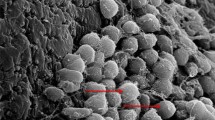Abstract
The pathomechanism of chronic rhinosinusitis with nasal polyposis (CRS/NP) seems to be unclear. Bacterial-, fungal- and combined biofilms might play a potential role in the pathogenesis of various inflammatory diseases and recently in CRS/NP. A prospective, blinded observational study was performed to confirm that the combination of conventional hematoxylin–eosin (HE) and Gram staining protocols could be used to detect bacterial and fungal biofilms in patients with CRS/NP. A total of 50 patients with CRS/NP undergoing endoscopic sinus surgery (ESS) were analyzed. The negative control group consisted of 12 patients undergoing septoplasty for nasal obstruction without CRS/NP. The nasal polyps and inferior turbinate mucosa specimens applied as negative controls were processed to HE and Gram staining. Biofilm was detected in 44 of 50 patients with CRS/NP and in none of 12 negative controls. In our series, HE method showed an obvious correlation with the results of Gram staining and was allocated to be a good predictor of biofilm existence. It was found that the microscopic structure and thickness of biofilms were strongly associated with the integrity of nasal mucosa and with the characteristics of subepithelial cellular infiltration. This study confirmed the presence of bacterial and fungal biofilms on the surface of NPs obtained from patients with CRS. Since biofilms may affect the severity and recurrence rate of CRS treated by ESS they should be detected histologically. In conclusion, HE staining combined with Gram protocol is a robust and reliable method for the detection of bacterial and fungal biofilms in CRS/NP.





Similar content being viewed by others
References
Marple BF, Stankiewicz JA, Baroody FM, Chow JM, Conley DB, Corey JP, Ferguson BJ, Kern RC, Lusk RP, Naclerio RM, Orlandi RR (2009) Parker MJ; American Academy of Otolaryngic Allergy Working Group on Chronic Rhinosinusitis. Diagnosis and management of chronic rhinosinusitis in adults. Postgrad Med 121(6):121–139
Al-Mutairi D, Kilty SJ (2011) Bacterial biofilms and the pathophysiology of chronic rhinosinusitis. Curr Opin Allergy Clin Immunol 11(1):18–23
Suh JD, Ramakrishnan V, Palmer JN (2010) Biofilms. Otolaryngol Clin North Am 43(3):521–530
Foreman A, Psaltis AJ, Tan LW, Wormald PJ (2009) Characterization of bacterial and fungal biofilms in chronic rhinosinusitis. Am J Rhinol Allergy 23(6):556–561
Healy DY, Leid JG, Sanderson AR, Hunsaker DH (2008) Biofilms with fungi in chronic rhinosinusitis. Otolaryngol Head Neck Surg 138(5):641–647
Mladina R, Skitarelić N, Musić S, Ristić M (2010) A biofilm exists on healthy mucosa of the paranasal sinuses: a prospectively performed, blinded, scanning electron microscope study. Clin Otolaryngol 35(2):104–110
Perloff JR, Palmer JN (2004) Evidence of bacterial biofilms on frontal recess stents in patients with chronic rhinosinusitis. Am J Rhinol 18(6):377–380
Zernotti ME, Angel Villegas N, Roques Revol M, Baena-Cagnani CE, Arce Miranda JE, Paredes ME, Albesa I, Paraje MG (2010) Evidence of bacterial biofilms in nasal polyposis. J Investig Allergol Clin Immunol 5:380–385
Foreman A, Wormald PJ (2010) Different biofilms, different disease? A clinical outcomes study. Laryngoscope 120(8):1701–1706
Ferguson BJ, Stolz DB (2005) Demonstration of biofilm in human bacterial chronic rhinosinusitis. Am J Rhinol 19(5):452–457
Mladina R, Poje G, Vuković K, Ristić M, Musić S (2008) Biofilm in nasal polyps. Rhinology 46(4):302–307
Psaltis AJ, Ha KR, Beule AG, Tan LW, Wormald PJ (2007) Confocal scanning laser microscopy evidence of biofilms in patients with chronic rhinosinusitis. Laryngoscope 117(7):1302–1306
Hochstim CJ, Choi JY, Lowe D, Masood R, Rice DH (2010) Biofilm detection with hematoxylin-eosin staining. Arch Otolaryngol Head Neck Surg 136(5):453–456
Hekiert AM, Kofonow JM, Doghramji L, Kennedy DW, Chiu AG, Palmer JN, Leid JG, Cohen NA (2009) Biofilms correlate with TH1 inflammation in the sinonasal tissue of patients with chronic rhinosinusitis. Otolaryngol Head Neck Surg 141(4):448–453
Galli J, Calò L, Ardito F, Imperiali M, Bassotti E, Passali GC, La Torre G, Paludetti G, Fadda G (2008) Damage to ciliated epithelium in chronic rhinosinusitis: what is the role of bacterial biofilms? Ann Otol Rhinol Laryngol 117(12):902–908
Young D, Morton R, Bartley J (2010) Therapeutic ultrasound as treatment for chronic rhinosinusitis: preliminary observations. J Laryngol Otol 124(5):495–499
Acknowledgments
This work was supported by the grants from Hungarian Scientific Research Fund (OTKA PD75371) and from Mecenatúra Fund of Debrecen University (DE OEC Mec 17/2008).
Author information
Authors and Affiliations
Corresponding author
Rights and permissions
About this article
Cite this article
Tóth, L., Csomor, P., Sziklai, I. et al. Biofilm detection in chronic rhinosinusitis by combined application of hematoxylin-eosin and gram staining. Eur Arch Otorhinolaryngol 268, 1455–1462 (2011). https://doi.org/10.1007/s00405-011-1623-x
Received:
Accepted:
Published:
Issue Date:
DOI: https://doi.org/10.1007/s00405-011-1623-x




